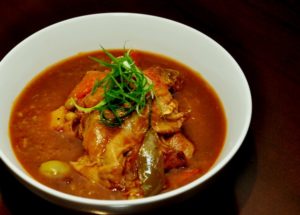
Stewed Cabrito (Cebu Style Caldereta)
OLD prominent families in Cebu like the Aznars have heritage dishes and the recipes are kept within the family.
It has been over a year now since cosmopolitan Chef/Sommelier Stephen Aznar decided to share his culinary talent and skills honed for many years abroad, particularly in New York City.
Stephen dishes out his brand of culinary sophistication at Cocina dela Casa in a 1960’s white house, elegant and homey, along Morales street close to Gorordo Avenue.
A seasoned traveller, his eclectic menu reflects the cuisine of places he has visited. The Southeast Asian flavors are close to his discerning palate. But his Cebuano Heritage Cuisine finally finds its way into his refined menu.
Fresh from his trip to Bacolod and Iloilo, Chef Stephen finally found the time to share his Cebuano Heritage Cuisine at his Cocina dela Casa. To my sheer joy, he was raving about my cassava cake that I gifted him over the holidays.
He claims he is not a dessert person but he enjoyed seconds of the cassava cake with grilled coconut cream topping.
He was in a huddle with his lawyer when we arrived so we had time to appreciate the first solo exhibit of Negrense artist Jon Ray Fernandez. With an eye for the arts, Stephen displays selected artworks in his spacious dining area.
Chef Stephen has selected dishes that he grew up with for his Cebuano Heritage Cuisine menu.
To open up our palates, we picked on kinilaw, slices of Emperor Bream (Katambak) in coconut cream rendered sour with vinegar and topped with thin curls of spring onion, tomatoes and red bell pepper.
A fleshy white fish with reddish skin, I also like katambak cooked “inun-unan” or ”paksiw.” His “chicharon”, delicately crunchy skin with thin layers of fat and flesh was sinfully indulging.
Stephen says, his ”chicharon” is always cooked fresh and hot when served. His ”dugo-dugo” is his mother’s recipe. Cocina’s junior cook, Adrin Comeros, explained that the bloody dish uses pork and chicken gizzard (not the usual innards) sautéed in garlic onion, chilies and herbs while the pork blood is cooked separately with vinegar to avoid curdling. His ”humba,” a Chinese dish adopted by Cebuanos, is an original recipe from his Chinese friend, Juanito Uy.
The slow-cooked pork hock in soy sauce, vinegar, brown sugar, garlic, star anise and black beans was topped with “budburon buwad” giving it an interesting twist.
Australian Rooks Lane wines were generously poured. I preferred chardonnay while Stephen and the rest had Shiraz, both young wines with 2016 vintage.
Stephen shares family recipes of the Aznars with the stewed cabrito or Cebu-style caldereta, young goat’s meat simmered in tomato sauce with red bell pepper, olives with the addition of carrots, potatoes and cooking bananas (saba).
The sauce is thickened with pounded soda crackers. The House Special Callos is classic—beef knuckles, shank, tripe, Spanish chorizo, chickpeas, pimiento and paprika. The meat morsels were all gelatinously tender.
Dessert was served in the private room on the second floor, an elegant space with a few of Stephen’s collections, including a unique chair and paintings.
The comedor can sit eight to 10 persons.
While the gentlemen enjoyed conversation with the wines, I chose to indulge in the desserts: sticky rice with mangoes, Borracho and Banana Fritters in Lemon Caramel Sauce.
